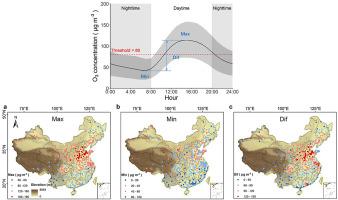Environmental Pollution ( IF 7.6 ) Pub Date : 2021-06-09 , DOI: 10.1016/j.envpol.2021.117547 Nan Xia 1 , Enzai Du 1 , Zhaodi Guo 2 , Wim de Vries 3

|
China is experiencing severe tropospheric ozone pollution, especially during the summer period in cities. Previous studies have assessed the role of meteorological conditions and anthropogenic precursors in shaping the diurnal variation of ozone concentration in some Chinese cities or the spatial patterns of daytime ozone concentration, but less is known about the spatial variation and main regulators of the diurnal cycle of summer ozone concentrations in Chinese cities. Using monitoring data from 367 cities, we analyzed the spatial patterns and main regulators of daytime maximum, nighttime minimum and diurnal difference of summer (June–August) ozone concentrations during 2015–2019. National mean values and standard deviations of daytime maximum and nighttime minimum of summer surface ozone concentration were 124.1 ± 27.5 and 33.4 ± 13.0 μg m−3, resulting in a diurnal difference of 90.7 ± 25.2 μg m−3. High values of daytime maximum, nighttime minimum, and diurnal difference of summer ozone concentrations occurred in cities in northern China, especially in the North China Plain, and several city agglomerations in southern China. Daytime maximum ozone concentrations were higher in cities with higher daytime PM2.5 and/or NO2 concentrations, lower daytime precipitation and lower elevation. Nighttime minimum ozone concentration increased with lower nighttime precipitation, lower NO2 concentration and CO concentration, higher nighttime maximum PM2.5 concentration and higher elevation. Diurnal difference of ozone concentration increased with lower elevation, lower daytime precipitation, and higher diurnal difference of CO and NO2 concentrations. Our findings highlight different regulators for daytime and nighttime ozone and imply the need of joint regulation of PM2.5 and NO2 emissions to control ozone pollution.











































 京公网安备 11010802027423号
京公网安备 11010802027423号